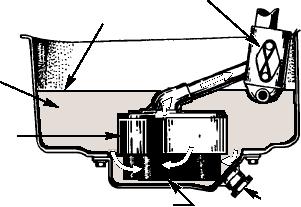
of paper or a composition of paper and other materials,
FLOATING STRAINER.--The floating strainer
and must be replaced periodically.
has a sealed air chamber, is hinged to the oil pump inlet,
and floats just below the top of the oil. As the oil level
FULL FLOW FILTERS.--Full flow filters (fig.
changes, the floating intake will rise or fall
5-15) are designed to filter the full oil output of the
accordingly. Thus, all oil taken into the pump comes
pump. This type of filter strains all of the oil before it is
from the surface. This prevents the pump from
distributed to the engine.
drawing oil from the bottom of the oil pan, where dirt,
With the full flow type filter, a relief or bypass
water, and sludge are likely to collect. The strainer
valve must be provided to allow the oil to flow around
screen is held to the float by a holding clip, and the up
the filter in the event the filter becomes clogged. This
or down movement of the float is limited by stops.
valve opens when the back pressure caused by
FIXED STRAINER.--The fixed strainer is
clogging becomes greater than the tension of the valve
simply an inverted funnel-like device, as shown in
spring. The engine is thus assured an adequate supply
figure 5-14, placed about 1/2 inch to 1 inch from the
of oil in case of filter failure. The bypass valve is
incorporated in the filter assembly or located in the
bottom of the oil pan. Thus, any sludge or dirt
engine block near the filter.
accumulation in the bottom of the pan is prevented
from circulating through the system. The assembly is
PARTIAL FLOW FILTERS.--Partial flow
attached solidly to the oil pump in a fixed position.
filters (fig. 5-16) strain only a small amount of the oil
being circulated by the pump. The oil from the main oil
Oil Filters
gallery enters the filter and flows through the filter
element. It then passes into the metal perforated
The oil cleaner, or filter, is placed in the oil line
collector in the center of the filter. The filtered oil then
beyond the pump and is usually mounted on the engine
flows out the outlet, which is restricted to prevent loss
in an accessible location. The average automotive
of pressure. After passing through the restriction, the
engine uses a single filter while larger engines,
oil either returns to the crankcase directly or by way of
especially diesel, use banks of two or more filters.
the timing gears, rocker arms, or other parts needing
The filter cleans the oil and removes most of the
lubrication. Where the return oil is used for lubricating
such parts, a bypass valve must be used to assure
impurities that were picked up by the oil as it circulated
circulation in the event the filter becomes clogged. A
through the engine. The filter is connected so that the
drain plug is usually incorporated in the bottom of the
oil passes through it each time the oil is circulated
filter case for sludge removal.
through the engine. Some oil filters have washable
filter elements and some have replaceable elements or
Oil Level Gauge
cartridges, while still others require replacement of the
entire assembly.
The oil level gauge, known also as a dipstick, is
The elements themselves may be either metallic or
usually of the bayonet type. It consists of a long rod or
nonmetallic. The metallic elements are made of
blade that extends into the oil pan. It is marked to show
bronze and are more or less permanent, since they are
EMPTY, LOW, and FULL, or sometimes just LOW
washable. Nonmetallic filter elements are composed
and FULL or FULL and ADD. Readings are taken by
OIL PUMP
OIL LEVEL
LOWER
OIL
INLET
SHIELD
DRAIN
OIL INLET SCREEN
ASf05014
PLUG
Figure 5-14.--Fixed oil strainer.
5-18

